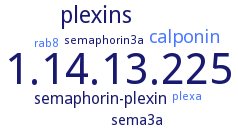1.14.13.225: F-actin monooxygenase
This is an abbreviated version!
For detailed information about F-actin monooxygenase, go to the full flat file.

Word Map on EC 1.14.13.225 
-
1.14.13.225
-
plexins
-
calponin
-
semaphorin-plexin
-
sema3a
-
plexa
-
semaphorin3a
-
rab8
- 1.14.13.225
-
plexins
- calponin
-
semaphorin-plexin
-
sema3a
- plexa
-
semaphorin3a
- rab8
Reaction
Synonyms
MICAL, MICAL-1, MICAL-2, MICAL1, Mical2, MICAL2PV, MICAL3
ECTree
Advanced search results
Disease
Disease on EC 1.14.13.225 - F-actin monooxygenase
Please use the Disease Search for a specific query.
Please wait a moment until all data is loaded. This message will disappear when all data is loaded.
Adenocarcinoma of Lung
MICAL2 is a novel nucleocytoplasmic shuttling protein promoting cancer invasion and growth of lung adenocarcinoma.
Anthracosilicosis
[Cellular metabolism in nasal lining and buccal epithelium in coal miners]
Arrhythmias, Cardiac
MICAL1 constrains cardiac stress responses and protects against disease by oxidizing CaMKII.
Breast Neoplasms
MICAL1 controls cell invasive phenotype via regulating oxidative stress in breast cancer cells.
Breast Neoplasms
MICAL1 facilitates breast cancer cell proliferation via ROS-sensitive ERK/cyclin D pathway.
Breast Neoplasms
MICAL1 regulates actin cytoskeleton organization, directional cell migration and the growth of human breast cancer cells as orthotopic xenograft tumours.
Breast Neoplasms
MICAL2 is expressed in cancer associated neo-angiogenic capillary endothelia and it is required for endothelial cell viability, motility and VEGF response.
Breast Neoplasms
MICAL2 promotes breast cancer cell migration by maintaining epidermal growth factor receptor (EGFR) stability and EGFR/P38 signalling activation.
Breast Neoplasms
Semaphorin signaling via MICAL3 induces symmetric cell division to expand breast cancer stem-like cells.
Carcinogenesis
MICAL2 Mediates p53 Ubiquitin Degradation through Oxidating p53 Methionine 40 and 160 and Promotes Colorectal Cancer Malignance.
Colorectal Neoplasms
MICAL2 Mediates p53 Ubiquitin Degradation through Oxidating p53 Methionine 40 and 160 and Promotes Colorectal Cancer Malignance.
Epilepsy
Expression pattern of Mical-1 in the temporal neocortex of patients with intractable temporal epilepsy and pilocarpine-induced rat model.
Epilepsy, Temporal Lobe
Expression pattern of Mical-1 in the temporal neocortex of patients with intractable temporal epilepsy and pilocarpine-induced rat model.
Glioblastoma
MICAL2 is expressed in cancer associated neo-angiogenic capillary endothelia and it is required for endothelial cell viability, motility and VEGF response.
Latent Infection
Identification potential biomarkers in pulmonary tuberculosis and latent infection based on bioinformatics analysis.
Lentivirus Infections
MICAL2 regulates myofibroblasts differentiation in epidural fibrosis via SRF/MRTF-A signaling pathway.
Liver Cirrhosis
LncRNA Mical2/miR-203a-3p sponge participates in epithelial-mesenchymal transition by targeting p66Shc in liver fibrosis.
Lymphatic Metastasis
MICAL2 is a novel nucleocytoplasmic shuttling protein promoting cancer invasion and growth of lung adenocarcinoma.
Melanoma
Sema6A and Mical1 control cell growth and survival of BRAFV600E human melanoma cells.
Myxoma
MICAL2 is expressed in cancer associated neo-angiogenic capillary endothelia and it is required for endothelial cell viability, motility and VEGF response.
Neoplasm Metastasis
Identification and expression analysis of mical family genes in zebrafish.
Neoplasm Metastasis
MICAL2 is a novel human cancer gene controlling mesenchymal to epithelial transition involved in cancer growth and invasion.
Neoplasm Metastasis
MICAL2 promotes breast cancer cell migration by maintaining epidermal growth factor receptor (EGFR) stability and EGFR/P38 signalling activation.
Neoplasm Metastasis
Overexpression of MICAL2, a novel tumor-promoting factor, accelerates tumor progression through regulating cell proliferation and EMT.
Neoplasms
Amplification of F-Actin Disassembly and Cellular Repulsion by Growth Factor Signaling.
Neoplasms
Development and clinical validation of a novel 9-gene prognostic model based on multi-omics in pancreatic adenocarcinoma.
Neoplasms
MICAL redox enzymes and actin remodeling: New links to classical tumorigenic and cancer pathways.
Neoplasms
MICAL1 regulates actin cytoskeleton organization, directional cell migration and the growth of human breast cancer cells as orthotopic xenograft tumours.
Neoplasms
MICAL2 Facilitates Gastric Cancer Cell Migration via MRTF-A-Mediated CDC42 Activation.
Neoplasms
MICAL2 is a novel human cancer gene controlling mesenchymal to epithelial transition involved in cancer growth and invasion.
Neoplasms
MICAL2 is a novel nucleocytoplasmic shuttling protein promoting cancer invasion and growth of lung adenocarcinoma.
Neoplasms
MICAL2 is expressed in cancer associated neo-angiogenic capillary endothelia and it is required for endothelial cell viability, motility and VEGF response.
Neoplasms
MICAL2 promotes breast cancer cell migration by maintaining epidermal growth factor receptor (EGFR) stability and EGFR/P38 signalling activation.
Neoplasms
ORN: Inferring patient-specific dysregulation status of pathway modules in cancer with OR-gate Network.
Neoplasms
Overexpression of MICAL2, a novel tumor-promoting factor, accelerates tumor progression through regulating cell proliferation and EMT.
Neoplasms
Semaphorin signaling via MICAL3 induces symmetric cell division to expand breast cancer stem-like cells.
Osteoarthritis
Allelic expression analysis of the osteoarthritis susceptibility locus that maps to MICAL3.
Prostatic Neoplasms
Expression of novel molecules, MICAL2-PV (MICAL2 prostate cancer variants), increases with high Gleason score and prostate cancer progression.
Seizures
Expression pattern of Mical-1 in the temporal neocortex of patients with intractable temporal epilepsy and pilocarpine-induced rat model.
Spinal Cord Injuries
MICAL flavoprotein monooxygenases: expression during neural development and following spinal cord injuries in the rat.
Spinal Cord Injuries
MICAL1 (molecule interacting with CasL 1) protects oligodendrocyte cells from oxidative injury through regulating apoptosis, autophagy in spinal cord injury.
Stomach Neoplasms
MICAL2 Facilitates Gastric Cancer Cell Migration via MRTF-A-Mediated CDC42 Activation.
Stomach Neoplasms
NEDD9 Facilitates Hypoxia-Induced Gastric Cancer Cell Migration via MICAL1 Related Rac1 Activation.
html completed


 results (
results ( results (
results ( top
top









